Pilots of the Future
Throughout the first half of the twentieth century, popular science fiction promoted an individual, "great man" narrative of space adventure, in which a single hero (usually with an appropriately space-age name) led the charge. By the 1970s, however, this appears to have become relatively rare. In this entry I take a look at some examples of these pilots of the future and consider what they have to tell us about human spaceflight narratives.
The hero archetype in science fiction has a long history, which can be traced back through fantasy and mythology to Beowulf, Gilgamesh and Prometheus. Such men were portrayed as defying the gods, ruling nations, and leading vast quests - a reflection of the cultural milieu that shaped western civilisation. They evolved into the modern superhero - Superman, Batman, etc - and more conventional, human action-hero characters such as Rider Haggard’s Allan Quatermain, W E John’s Biggles, or comic character Doc Savage. Contemporary with some of these, the same cultural archetype manifested in early science fiction.
Amongst the earliest adventure heroes in space, Buck Rogers and Flash Gordon rose to prominence in comic strips and then movie serials, often shown alongside a cinematic main feature.
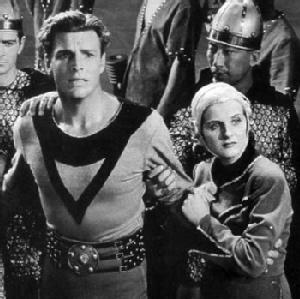 The character to whom we likely owe a whole string of successors with silly names, Buck Rogers, first appeared in the novel Armageddon: 2419AD (Nowlan 1928), before featuring in a comic strip from 1929, a radio play and a film serial in 1939. Variously described as William or Anthony “Buck” Rogers, the character has been reinvented frequently since, notably in television’s Buck Rogers in the 25th Century (1979-1981), which rode the wave of the science fiction revival that followed Star Wars (1977).
The character to whom we likely owe a whole string of successors with silly names, Buck Rogers, first appeared in the novel Armageddon: 2419AD (Nowlan 1928), before featuring in a comic strip from 1929, a radio play and a film serial in 1939. Variously described as William or Anthony “Buck” Rogers, the character has been reinvented frequently since, notably in television’s Buck Rogers in the 25th Century (1979-1981), which rode the wave of the science fiction revival that followed Star Wars (1977).
The central character is a contemporary American, displaced in time to a post-apocalyptic future where he encounters (and rescues) a female warrior: Wilma Deering. Originally earth-bound in the novel, later adaptations moved the setting for most of the adventures to space. Rogers, initially confused and disoriented, later becomes more confident in his new situation and takes on more traditional leadership positions. It’s interesting to note that Rogers’ origins provide a strong clue to his role: as a time-displaced contemporary of the readers, he provides a self-identification character for them. As the world is explained to him, it is also explained to the audience [1]. In that light it’s interesting to note that some commentators have placed the hero archetype firmly in the role of self-identification characters designed as fantasy-fulfilment for adolescent boys. Certainly many of Buck Rogers' comic adventures, and his frequent rescues of an often scantily-clad Wilma, appear to have been targeted at that audience.
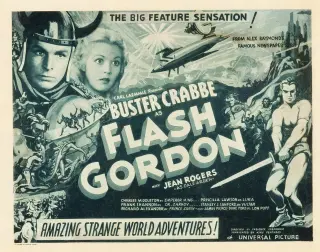 The very similar Flash Gordon was created as a comic strip character in 1934, and appeared in film serials in 1936-1940, before going on to have a long afterlife in reinventions and adaptations. Indeed the similarity was enhanced for early audiences by the fact that the same artiste, ex-Olympian Buster Crabbe, played both characters in the original film serials.
The very similar Flash Gordon was created as a comic strip character in 1934, and appeared in film serials in 1936-1940, before going on to have a long afterlife in reinventions and adaptations. Indeed the similarity was enhanced for early audiences by the fact that the same artiste, ex-Olympian Buster Crabbe, played both characters in the original film serials.
In contrast to Rogers (who was shown as having a military background which varied slightly between incarnations), Gordon was a youthful sportsman. Almost by accident, he set off on a spaceship along with his love-interest, Dale Arden, and a scientist Dr Zarkov, crashing into the complex worldscape of Mongo, its habitable moons and its environs. Explicitly commissioned as a commercial rival to Buck Rogers, these serials took on many of the tropes of its predecessor: a handsome, human hero with a supporting cast of love interests, scientists and villains.
Perhaps due to the influence of these characters, and in the revival of interest in space travel which followed World War II, the 1950s appears to have been a peak era for silly-named-hero science fiction.
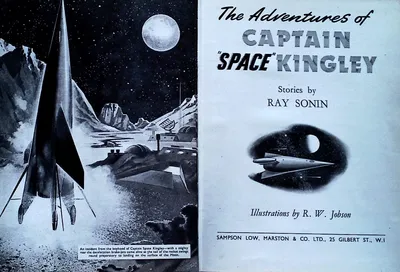 Leading the charge was Dan Dare: Pilot of the Future, first appearing in comic strip form in the Eagle magazine in 1950. Designed as a morally-upright, very British, fighter-pilot style action hero, Colonel Daniel McGregor Dare has gone on to lead his crew of fellow space-fleet officers, scientist Professor Jocelyn Peabody and other allies through adventures in a variety of formats over the course of seven decades. These have included comic strips, radio plays, and television adventures, as well as a series of audio dramas that have also been radio broadcast. Dan Dare's persistent impact on British culture has been recognised in exhibitions at London's science museum which have explored the public perception of science in the 1950s and 60s. He also generated a number of imitators including Captain “Space” Kingsley (1952-1954), who appeared in dedicated children’s annuals [2].
Leading the charge was Dan Dare: Pilot of the Future, first appearing in comic strip form in the Eagle magazine in 1950. Designed as a morally-upright, very British, fighter-pilot style action hero, Colonel Daniel McGregor Dare has gone on to lead his crew of fellow space-fleet officers, scientist Professor Jocelyn Peabody and other allies through adventures in a variety of formats over the course of seven decades. These have included comic strips, radio plays, and television adventures, as well as a series of audio dramas that have also been radio broadcast. Dan Dare's persistent impact on British culture has been recognised in exhibitions at London's science museum which have explored the public perception of science in the 1950s and 60s. He also generated a number of imitators including Captain “Space” Kingsley (1952-1954), who appeared in dedicated children’s annuals [2].
The influence of Dan Dare was undoubtedly being felt when the BBC recorded the classic radio series Journey Into Space. While the title appears relatively benign, and the story is, in fact, an ensemble piece focussing on a crew of four, the writer Charles Chilton chose to begin every episode with the announcement: “The BBC presents Jet Morgan in: Operation Luna!” (or The Red Planet! or The World in Peril! as appropriate). Arguably cockney radio operator Lemmy Barnett is the audience self-identification character here, and often drives the plot, but nonetheless it is the dashing, heroic and well-spoken Captain Andrew “Jet” Morgan who makes the headlines.
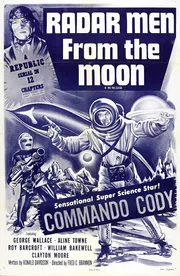 Writing for juvenile readers, well-known author Isaac Asimov wrote a series of books featuring undercover agent David “Lucky” Starr (1952-1958), who was name-checked in each title. These books took the eponymous character on a tour of planets of the Solar System, encountering a variety of problems along the way, while introducing then-current contemporary understanding of our neighbouring planets.
Writing for juvenile readers, well-known author Isaac Asimov wrote a series of books featuring undercover agent David “Lucky” Starr (1952-1958), who was name-checked in each title. These books took the eponymous character on a tour of planets of the Solar System, encountering a variety of problems along the way, while introducing then-current contemporary understanding of our neighbouring planets.
Back in the world of American movie theatre science fiction film serials, we encounter the "sensational super science star" Commando Cody who appeared in serials Radar Men from the Moon (1952) and the ambitiously titled Commando Cody: Sky Marshall of the Universe (1953). Cody is essentially a rocket-jetpack inventor who become's Earth front-line defender and fights off alien invasion with the help of his love interest Joan and other friends. It's never explained why he is referred to as a commando.
By the 1960s, the prominence given to individual hero characters began to decline. Television series including Star Trek, Lost in Space, Land of the Giants and others all featured strong ensemble casts, with equal or near-equal billing for the characters. Similarly UK children's SF television such as Pathfinders in Space, Stingray or Thunderbirds focussed on a family or team dynamic. Exceptions did still occur, notably Captain Scarlet and the Mysterons in the 1960s, and perhaps even Blake’s 7 in the 1980s, but these became rarer [3].
But this is a blog about science and science fiction, not heroic fantasy, so why am I telling you all this? Well, I believe that the way science fiction has been cast over time can tell us about aspects of the history of science in popular perception. Whether deliberately or not, the writers are reflecting their understanding of space, technology and scientific discovery.
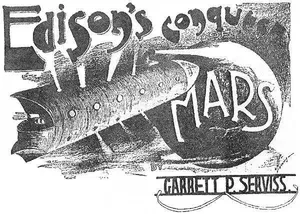 While early SF may well have been attuned to adolescent male self-images (see SFE: Heroes), that self-image was in turn shaped partly by the narratives of individual heroism which abounded in the nineteenth and early twentieth century. Individuals such as Clive of India, Lawrence of Arabia and various military generals were held up as role models. These propagated into fiction, notably in children’s characters such as World War One fighter pilot ace, Biggles. Popular perceptions of scientific endeavour fell into the same kind of pattern: prominent scientists of the nineteenth century were succeeded by big-name characters such as Albert Einstein, Ernest Rutherford and Enrico Fermi, who made headlines in the early twentieth century and scooped major discoveries and prizes. Self-publicist inventors such as Tesla, Marconi and notably Thomas Edison also appeared frequently in the press and other media. Indeed, one of the earliest responses to H G Wells’ War of the Worlds was Edison's Conquest of Mars (Serviss 1898).
While early SF may well have been attuned to adolescent male self-images (see SFE: Heroes), that self-image was in turn shaped partly by the narratives of individual heroism which abounded in the nineteenth and early twentieth century. Individuals such as Clive of India, Lawrence of Arabia and various military generals were held up as role models. These propagated into fiction, notably in children’s characters such as World War One fighter pilot ace, Biggles. Popular perceptions of scientific endeavour fell into the same kind of pattern: prominent scientists of the nineteenth century were succeeded by big-name characters such as Albert Einstein, Ernest Rutherford and Enrico Fermi, who made headlines in the early twentieth century and scooped major discoveries and prizes. Self-publicist inventors such as Tesla, Marconi and notably Thomas Edison also appeared frequently in the press and other media. Indeed, one of the earliest responses to H G Wells’ War of the Worlds was Edison's Conquest of Mars (Serviss 1898).
So what, if anything, changed?
By the late 1940s and into the 1950s, science was starting to be seen more as a team based and collective endeavour. This, of course, had always been true to a large extent, but increasingly individual names began to fade from popular view. Rather than a new telephone coming personally from Alexander Graham Bell or Thomas Edison, it came from the General Post Office (GPO, in the UK) or organisations such as Bell Labs (in the US). The atomic bomb came from the massive collective effort of the Manhattan Project; while individual scientists appeared as spokespeople, there was no desire or real attempt to claim individual credit [4]. Computers were seen to come from organisations such as IBM (and later the team at Bletchley Park was acknowledged as instrumental in their development).
In other words, the narrative of science in the public consciousness gradually changed from one driven by individuals to one driven by projects. Perhaps the apotheosis of this, cementing the concept in public awareness, was the Apollo Programme of the late 1960s. Neil Armstrong was the first man to walk on the Moon, but the space race highlighted a succession of such names, and wrapped them up with the vast technical expertise of both the American and Russian space endeavours. Unlike the early science fiction heroes, no one was claiming Armstrong and his shipmates built their own ship, or planned their mission themselves, based on courage and bravado.
It’s my belief that the shift in science fiction characterisation reflected this cultural shift in the perception of both science and space innovation. Gone were lone-wolves in their private spaceships, in were well-organised missions and crew ensembles. Where, if it had been written twenty years earlier, Angus McGregor’s Super Nova and the Rogue Satellite (1969) might have been expected to feature special agent Nova solving the eponymous problem, it in fact it was the crew of space-lifeboat Super Nova that handled it collectively. And rather than something like “Freedom Blake and the Rebellion” we had Blake’s 7, with its cohort focus.
Of course, the shifts I’ve discussed are likely just part of a wider web of interconnected cultural changes. There’s also been something of a shift back in the opposite direction in the last couple of decades, with individual tech millionaires such as Gates, Bezos and Musk again rising to prominence. Nevertheless, I think the rise and fall of the space hero pilot gives us an interesting glimpse into the way twentieth century science fiction reflected the world around it... and also gave us some great silly names.
"Pilot of the Future", Elizabeth Stanway. Cosmic Stories blog. 23rd January 2022
[1] This, of course, is also the role of sidekicks such as Sherlock Holmes’ Doctor Watson or Dan Dare's Albert Digby, and companions such as the Doctor’s many assistants in Doctor Who. [Back to text]
[2] It’s hard to imagine how a young Dan Dare fan would have reacted to receiving such an annual as a gift - joy at finding more space adventures, or disappointment that they didn’t contain the familiar characters of Dan Dare’s world. Other comics and their annuals of the time also followed this trend. Lion comic had a character called Captain Condor from 1952 onwards. Around the same time, Whopper Space Stories introduced us to Rex Strong, Space Barr and Commander Steel. An honourable mention is deserved here by Professor Brane who may not himself been a hero, but who took Timothy "Tiger" Clinton out of this world in Kings of Space (Johns, 1954). [Back to text]
[3] The supermarionation (i.e. puppet) and other science fiction series produced by Gerry Anderson and the team of A P Films (later Century 21) actually provides an interesting arc here. The principle heroes of these stories include Mike Mercury (Supercar, 1961), Steve Zodiac (Fireball XL5, 1962), Troy Tempest (Stingray, 1964), Scott Tracy (Thunderbirds, 1965), Paul Metcalfe (Captain Scarlet, 1967), Joe McClaine (Joe 90, 1968), Father Unwin (The Secret Service, 1969), Edward Straker (UFO, 1970), John Koenig (Space:1999, 1975). The shift from novelty names to more anonymous, normal character names which often formed part of an ensemble cast rather than driving the action themselves is noticeable. [Back to text]
[4] Indeed the Second World War may well have also played a role in this cultural shift - the mechanised warfare of the first half of the twentieth century shifted the focus from individual warrior soldiers to the joint efforts of groups. The technical requirements of modern weaponry required large teams, not only to produce but also to maintain and deploy. [Back to text]
Image sources: Photograph of own copy of Space Kingsley, image from Edison's Conquest of Mars sourced from gutenberg.org, movie posters and screenshots sourced online under fair use provisions for criticism or comment.
All views expressed herein are my own and not those of the University of Warwick.
